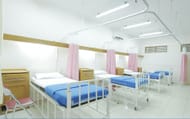Nosocomial pneumonia is also known as hospital-acquired pneumonia. As the name says, it's usually observed 48 hours after hospital admission and is not there at the time of admission.
Ventilator-associated pneumonia is also a subtype of condition that occurs in intensive care units. The condition is caused by bacteria like Pseudomonas aeruginosa, Escherichia coli, Klebsiella pneumoniae, Enterobacter spp, Acinetobacter spp., etc. The causative pathogen may vary from person to person.
In Europe and the United States, 5-10 per 1000 hospital admissions are found to be affected by nosocomial pneumonia, and over 90% of such conditions are associated with mechanical ventilation.
In this article, we bring you all about the pathophysiology of this condition along with available treatments.
Nosocomial pneumonia symptoms

Common signs and symptoms of this condition can include:
- Fever above 37.8 °C (100 °F)
- Thick sputum
- Reduced white blood cells
- Mental confusion
- Pus-like phlegm (sputum)
- Chills
- Uneasiness or feeling ill (malaise)
- Loss of appetite
- Nausea and vomiting
- Sharp chest pain during breathing or coughing
- Shortness of breath
- Decreased blood pressure
- Increased heart rate
In elderly people, the symptoms might be severe and last for days if not treated properly.
Identifying these symptoms early is essential for early treatment and management. Fever is the most common symptom in such infections. If you are not sure about the symptoms, though, consult your nearest doctor immediately. The doctor may also recommend tests to confirm the infection.
Causes of nosocomial pneumonia

Several studies have indicated the role of drug-resistant bacteria in the pathophysiology of this type of pneumonia.
Patients on chronic immunosuppressed medications and bone marrow transplant recipients get this infection due to their body's inability to protect itself under such conditions.
These microbes easily grow and stay on and inside medical equipment and the ventilator. The usage of respirator devices in critical care units often exposes patients to these pathogens, leading to infections.
The evolution of multi-drug-resistant microbes has led to an increase in instances of infections recently. Germs present in hospitals are more dangerous, as they develop resistance to antibiotics; hence, treatments might not be effective against them.
Nosocomial pneumonia can also be transmitted by healthcare workers, through their hands or clothes from one person to another. That makes hand-washing, wearing gloves and using other safety measures extremely important in the hospital.
Nosocomial pneumonia treatment

Antibiotics are usually used to treat these conditions, and there are guidelines regarding the usage schedule of antibiotics.
Generally, a fluoroquinolone antibiotic for respiratory infections (moxifloxacin) or amoxicillin with clavulanic acid along with a macrolide is used. Levofloxacin is an effective antibiotic for this condition and tuberculosis.
In 2005, the American Thoracic Society and Infectious Diseases Society of America introduced guidelines to treat nosocomial pneumonia, which included recommendations to use the following combination therapies to overcome drug resistance:
- cefepime, ceftazidime, imipenem, meropenem or piperacillin–tazobactam; along with
- ciprofloxacin, levofloxacin, amikacin, gentamicin, or tobramycin; along with
- linezolid or vancomycin
For infections in children and infants, cefepime, ceftazidime, linezolid, vancomycin, meropenem, cefotaxime, ceftobiprole or cephalosporin are often used.
However, recent research suggests that antibiotics are becoming ineffective against childhood infections due to drug resistance. To prevent organ failure, hospitalization is essential in the early stages.
If you or anyone else shows symptoms of nosocomial pneumonia after hospital discharge, consult a doctor immediately.
Indranil Biswas is a nutritionist and personal trainer with a diploma in dietetics and personal training with a specialization in sports nutrition and strength training.
What do you think of this story? Tell us in the comments section below.
